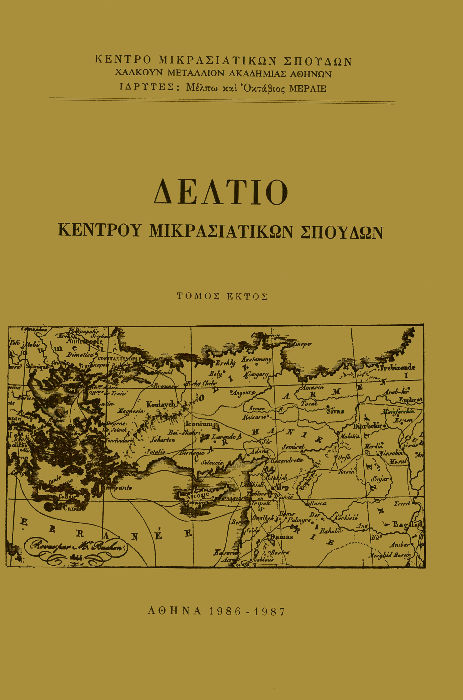Η αρχαιολογία της Μικράς Ασίας και η βρετανική αρχαιολογική σχολή Αθηνών
Περίληψη
The British School of Archaeology at Athens was established in 1886,
and the Annual of the British School at Athens (abbr. BSA ) was published
for the first time in 1895-96. The interest of the School in the
history and archaeology of Asia Minor has always been vivid and demonstrated
by several excavations and researches. This interest was especially strong in the first two decades of our century and in the late 50’s, as
can be seen from the articles published in the BSA (fig. 1). Most of the
articles on Asia Minor have been writen by prominent members of the
School, like F. W. Hasluck, J. Cook, W. Leaf, H. Ormerod, and A. M.
Woodward. These articles deal with a wide range of subjects, including
ancient topography, history of religion, and archaeology (architecture,
pottery, excavation reports, and notes on numismatics and inscriptions),
since prehistoric times; emphasis has, however, been given to the Classical
and Roman periods. Of special interest are Flasluck’s articles on Anatolian
folklore and the Medieval monuments of Asia Minor and his
studies on ancient and modern religions. J. M. Cook has written about
the pottery and topography of Ionia and scholars like Leaf, Ormerod, and
Woodward dealt with the topography and the Greek inscriptions from
various places of Asia Minor. Most of the articles have been written
about Smyrna, Constantinople, and Halikarnassos.
The multivariate researches and studies of the British scholars have
seriously increased our knowledge of the history of Asia Minor. They are
especially important for the study of Greek culture and life in Asia Minor
over a period of more than three thousand years, from prehistory to modern
times.
Λεπτομέρειες άρθρου
- Πώς να δημιουργήσετε Αναφορές
-
Κοσμόπουλος Μ. Β. (1986). Η αρχαιολογία της Μικράς Ασίας και η βρετανική αρχαιολογική σχολή Αθηνών. Δελτίο Κέντρου Μικρασιατικών Σπουδών, 6, 323–349. https://doi.org/10.12681/deltiokms.115
- Τεύχος
- Τόμ. 6 (1986)
- Ενότητα
- Άρθρα

Αυτή η εργασία είναι αδειοδοτημένη υπό το CC Αναφορά Δημιουργού – Μη Εμπορική Χρήση – Παρόμοια Διανομή 4.0.
Οι συγγραφείς των άρθρων που δημοσιεύονται στο Δελτίο διατηρούν τα δικαιώματα πνευματικής ιδιοκτησίας επί των άρθρων τους, δίνοντας στο περιοδικό το δικαίωμα της πρώτης δημοσίευσης. Άρθρα που δημοσιεύονται στο Δελτίο διατίθενται με άδεια Creative Commons 4.0 και σύμφωνα με την άδεια μπορούν να χρησιμοποιούνται ελεύθερα, με αναφορά στο/στη συγγραφέα και στην πρώτη δημοσίευση για μη κερδοσκοπικούς σκοπούς και με δικαίωμα τροποποίησης μόνον με παρόμοια διανομή (αν αναμείξετε, τροποποιήσετε, ή δημιουργήσετε πάνω στο υλικό, πρέπει να διανείμετε τις δικές σας συνεισφορές υπό την ίδια άδεια όπως και το πρωτότυπο).


